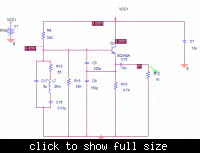halunke86
Newbie level 5
Hello,
i tried to design a colpitt oscillator (10mhz) in pspice, but there are some "start" problems. i got the data of the crystal oscillator (RLCC-network) of the german wikipedia (Schwingquarz) and the dimension of the parts from this site:
Transistor Crystal Oscillator Circuit :: Electronics and Radio Today
the only think i cannot realize is the additional capacitor below the crystal (placing it causes an node-error). does anybody recognize why this does not work?
and i have further question : can anybody tell me how i can dimension the parts for other frequencies? (i finally need a colpitt oscillator @ 16,3Mhz (local oscillator for a fm receiver))
thanks for help
halunke


i tried to design a colpitt oscillator (10mhz) in pspice, but there are some "start" problems. i got the data of the crystal oscillator (RLCC-network) of the german wikipedia (Schwingquarz) and the dimension of the parts from this site:
Transistor Crystal Oscillator Circuit :: Electronics and Radio Today
the only think i cannot realize is the additional capacitor below the crystal (placing it causes an node-error). does anybody recognize why this does not work?
and i have further question : can anybody tell me how i can dimension the parts for other frequencies? (i finally need a colpitt oscillator @ 16,3Mhz (local oscillator for a fm receiver))
thanks for help
halunke

